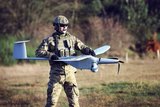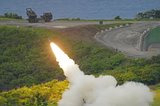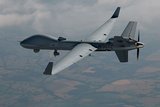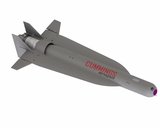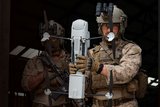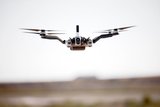DCNS achieves automatic UAV landing on frigate
On 9 and 10 October 2008, DCNS successfully landed a rotary-wing unmanned aerial vehicle (UAV) in automatic mode on French Navy frigate Montcalm while the ship was under way in the Mediterranean.
Until now, unresolved challenges involving UAV recovery by ships at sea have limited their deployment for safety reasons. The experimental solutions available to date have only worked reliably during daylight and in calm seas; two severe limitations for systems that are required to operate round the clock and in poor weather.
To overcome these shortcomings, DCNS developed the SADA automatic deck landing and take-off system. SADA takes less than 2 minutes to land a vertical take-off and landing (VTOL) UAV on a moving flight deck up to sea state 5. SADA uses an infrared sensor to accurately track the UAV while generating flight commands to adjust the trajectory until the UAV is positioned to ensure that its harpoon engages the centre of the landing grid. Tracking accuracy is 30 cm which is far better than that achieved by GPS-only systems. Overall safety and reliability are thus assured.
SADA features an open architecture and can be readily and unobtrusively integrated with any VTOL UAV and any type of ship.
This success is the result of close cooperation between DCNS and Austrian company Schiebel, manufacturer of the Camcopter S-100 UAV that performed the demonstration.
Thanks to this innovation, DCNS can now offer client navies an integrated solution for UAV deployment from mission planning to launch, execution and recovery. The components are thus available for the operational integration of VTOL UAVs with naval vessels.
UAVs promise to improve the air/sea surveillance capabilities of naval vessels. Key benefits include excellent endurance and loitering, danger-free for crews, low cost per flight hour, stealth and flexibility.
More from Uncrewed Vehicles
-
![What's next for the Pentagon after the Replicator programme?]()
What's next for the Pentagon after the Replicator programme?
Although the Replicator initiative has made several accomplishments, there are still multiple gaps to plug across the US Department of Defense (DoD) and its services.
-
![Cummings Aerospace showcases Hellhound loitering munition designed for US Army’s LASSO programme (video)]()
Cummings Aerospace showcases Hellhound loitering munition designed for US Army’s LASSO programme (video)
Cummings Aerospace presented its turbojet-powered Hellhound loitering munition at SOF Week 2025, offering a man-portable solution aligned with the US Army’s LASSO requirements.
-
![SOF Week 2025: PDW unveils attritable FPV drone for SOF operations at scale]()
SOF Week 2025: PDW unveils attritable FPV drone for SOF operations at scale
PDW has revealed its Attritable Multirotor First Person View drone at SOF Week 2025, offering special operations forces a low-cost, rapidly deployable platform for strike and ISR missions, inspired by battlefield lessons from Ukraine.
-
![SOF Week 2025: Teledyne FLIR white paper provides guidance on reusable loitering munitions]()
SOF Week 2025: Teledyne FLIR white paper provides guidance on reusable loitering munitions
Teledyne FLIR is highlighting the emerging requirements for 'recoverable and re-usable' loitering munitions across the contemporary operating environment during this week’s SOF Week conference in Tampa, Florida.
-
![SOF Week 2025: Kraken Technology group debuts K3 Scout USV in North America]()
SOF Week 2025: Kraken Technology group debuts K3 Scout USV in North America
High-performance maritime industry player Kraken Technology Group, based in the UK, has used the SOF Week conference in Tampa, Florida this week to debut its K3 Scout uncrewed surface vessel (USV) to the North American market.
-
![Palladyne AI and Red Cat to demonstrate capabilities for autonomous drone swarms to the US military]()
Palladyne AI and Red Cat to demonstrate capabilities for autonomous drone swarms to the US military
Red Cat and Palladyne AI recently conducted a cross-platform collaborative flight involving three diverse heterogeneous drones.








